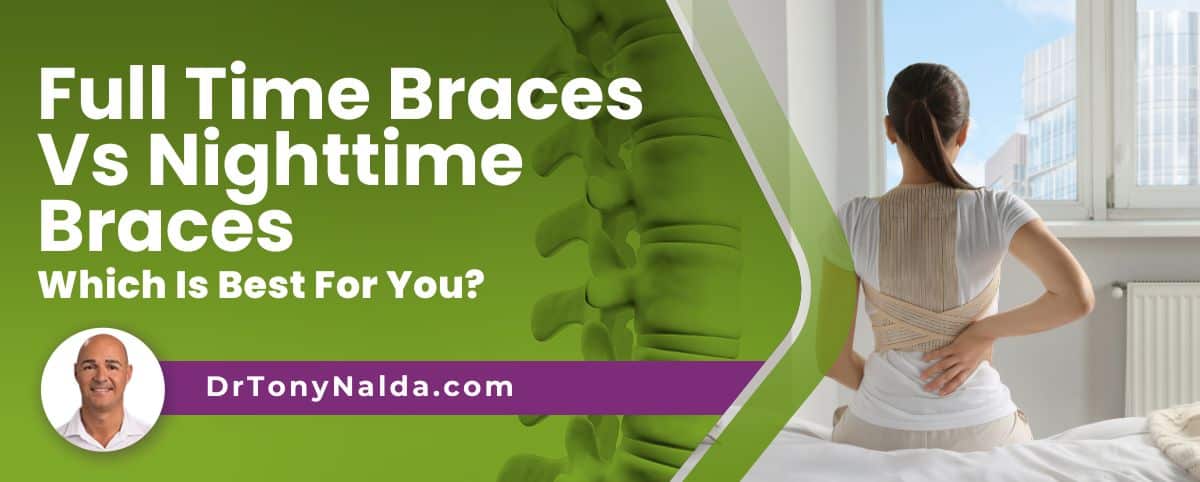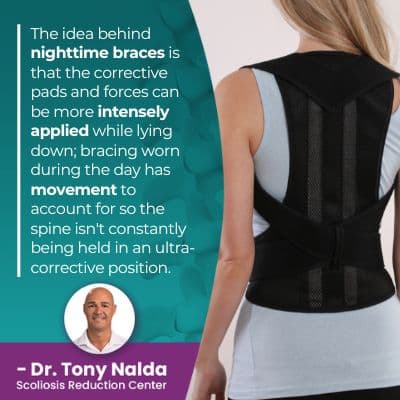Full Time Braces Vs Nighttime Braces: Which Is Best For You?

Scoliosis bracing uses the same principle as spinal fusion surgery: applying pressure to the spine to hold it in an aligned position. While no brace alone is enough to correct a scoliosis, a corrective brace can help augment corrective treatment results, when combined with other facets of treatment.
There are different types of scoliosis treatment and scoliosis braces. Some braces are prescribed for full-time wear, others for part-time, and others are designed to work during sleep so are only worn at nighttime. As each case is unique, the best brace will be case-specific.
Let's explore the most commonly-used full-time brace, nighttime brace, and corrective brace, while exploring the merits of the treatment approach they're aligned with.
Table of Contents
Full Time Braces
Full-time braces are worn as a facet of scoliosis treatment.
Scoliosis affects all ages but is most commonly diagnosed as adolescent idiopathic scoliosis, diagnosed between the ages of 10 and 18, and bracing is the most effective on spines that are still growing.
 Bracing is a regular facet of treatment for childhood scoliosis, and while different braces have different designs and goals, the underlying principle of applying pressure to the spine to affect its position is key.
Bracing is a regular facet of treatment for childhood scoliosis, and while different braces have different designs and goals, the underlying principle of applying pressure to the spine to affect its position is key.
As scoliosis develops, an unnatural spinal curve that also rotates is occurring, and as a progressive condition, the nature of the unnatural curvature of the spine is to get worse over time, meaning bigger and more severe.
The idea of scoliosis bracing is that by applying pressure to certain points along the curvature, the spine will be pushed, or squeezed (depending on the brace in question), into a straighter alignment.
Full-time braces are commonly recommended as part of adolescent idiopathic scoliosis treatment, to be worn while the spine is still growing, and full-time wear can mean anywhere from 21 to 23 hours a day, for up to five years.
Different factors determine the type of brace a patient is likely to be prescribed, along with the duration of treatment, such as patient age, condition type, severity, and chosen treatment approach; regardless of the brace in question, no brace will be effective if it's not worn exactly as it's prescribed.
Traditional Braces versus Corrective Braces
The most commonly used full-time brace in traditional scoliosis treatment is the Boston brace, and this often needs to be worn for up to 23 hours a day, until skeletal maturity has been reached.
Once the spine is no longer growing, it's not as easily adjusted, and the condition becomes compressive and painful, for adults.
The most commonly-used corrective brace is the ScoliBrace: a brace that represents the culmination of what we've learned about scoliosis, and scoliosis bracing, over the years.
Boston Brace
The Boston brace was designed in the '70s and its design has changed little since; it's a bulky and cumbersome design that wraps around the torso and is made from rigid plastic.
Considering the age of most patients using scoliosis braces (adolescents who want to blend in), the more a brace sets them apart from their peers, the more likely it is that compliance is going to be a challenge; this is a shortfall of the traditional Boston brace.
Particularly for full-time bracing, compliance has to be in place to be successful.
The Boston brace works by a type of three-point pressure system that uses pads that apply pressure along certain points of the curvature, and the pressure squeezes the spine into a straighter position; however, the excessive squeezing force, over time, is also known to weaken the spine and cause additional issues (breathing, skin chafing, activity restrictions).
The Boston brace is also limited in its potential efficacy because it ignores the condition's rotational forces, ignores the twist in the spine, and only treats scoliosis as a 2-dimensional condition.
The Boston brace is the most commonly used brace in traditional treatment, and although it can be prescribed for part-time wear, many patients wearing the Boston brace are prescribed for full-time wear.
Charleston Bending Brace
 When it comes to nighttime braces, the most commonly prescribed are the Providence nighttime brace and the Charleston bending brace, and the charleston is made from a cast taken of the torso; nighttime braces are worn for approximately 8 to 10 hours a day during sleep.
When it comes to nighttime braces, the most commonly prescribed are the Providence nighttime brace and the Charleston bending brace, and the charleston is made from a cast taken of the torso; nighttime braces are worn for approximately 8 to 10 hours a day during sleep.
The idea behind nighttime braces is that the corrective pads and forces can be more intensely applied while lying down; bracing worn during the day has movement to account for so the spine isn't constantly being held in an ultra-corrective position.
So braces worn at night are able to apply stronger forces that aren't restricted by movement considerations: having to keep the head centered over the torso and pelvis.
The Charleston is unique in that it doesn't just apply lateral pressure to adjust the spine's position; it also applies rotational forces and pressure to the bend so the spine is held in an over-corrected position.
Holding the spine in such an overcorrected bent position during the day, and while moving, isn't practical, but as a nighttime brace, the Charleston does its work while the patient is lying down in an over-corrected position.
So the question is whether or not the benefits of wearing a brace full-time, as in up to 23 hours a day, outweigh the benefits of nighttime bracing, with stronger forces applied, but for shorter periods of time.
Full-Time Bracing versus Nighttime Bracing
Each case of scoliosis is unique as scoliosis ranges widely in severity from mild to moderate and severe to very severe.
The condition also affects all ages and has different types that can develop, based on causation, so there is no standard treatment plan for scoliosis patients; the complex nature of the condition necessitates the customization of effective treatment plans.
Childhood scoliosis, because growth is the trigger for progression, should always be taken seriously, and as mentioned, adolescents want to fit in with their peers; they don't want to walk differently, stand differently, and most don't want to wear a rigid plastic brace that makes them look different.
Compliance is a big issue when it comes to brace efficacy; no brace on its own can correct a scoliosis, and even when combined with other effective types of scoliosis treatment, no brace, if not worn exactly as it's prescribed, will be effective.
Nighttime bracing has the benefit of better compliance because adolescents aren't wearing them to school and in front of their peers; they can wear them at night and feel like they blend in during the day.
Studies have shown, however, that when it comes to corrective forces, a full-time brace tends to produce better results as the spine is being continuously held in a corrective position.
While each case is unique, research supports that full-time bracing is recommended for younger patients and/or patients with severe thoracic scoliosis; nighttime bracing is commonly deemed more appropriate for older female adolescent patients who are menstruating and patients with lumbar scoliosis and/or milder conditions.
Conclusion
In addition to full time bracing and nighttime bracing in traditional treatment, there is also modern ultra-corrective bracing, and here at the Scoliosis Reduction Center, because it's aligned with a proactive conservative treatment approach, my brace of choice for growing spines is the ScoliBrace.
The ScoliBrace often has to be worn full time, but the difference is that it addresses many of the shortfalls associated with the Boston brace; it addresses the condition's true 3-dimensional nature, pushes the spine, instead of squeezing it (known to weaken the spine over time), and is fully customized to fit the patient's body type and curvature type.
Because the ScoliBrace uses state-of-the-art measuring and scanning technology to ensure that each brace is 100-percent bespoke to its wearer, patients find them more comfortable, less bulky, easier to take on and off, and easier to conceal under clothes: better compliance.
The modern ultra-corrective ScoliBrace has corrective results as its end goal, and because conservative treatment is proactive and integrative, it combines the benefits of corrective bracing with the power of chiropractic care, physical therapy, and rehabilitation.
Traditional treatment and braces are more aligned with a surgical response, so for those wanting to try a more natural and less-invasive response, conservative nonsurgical treatment has proven results that include preserving as much of the spine's natural strength and function as possible.
While full-time bracing is commonly recommended for larger curves, nighttime bracing can be more appropriate for smaller curves in older adolescent patients
So when it comes to determining the best scoliosis brace option for you, make sure that you are aware of all treatment options available because different scoliosis braces are aligned with a different treatment response; choosing between a traditional scoliosis treatment response with a traditional brace versus a modern conservative approach with a modern corrective brace will shape the spine's long-term spinal health and function.
Dr. Tony Nalda
DOCTOR OF CHIROPRACTIC
After receiving an undergraduate degree in psychology and his Doctorate of Chiropractic from Life University, Dr. Nalda settled in Celebration, Florida and proceeded to build one of Central Florida’s most successful chiropractic clinics.
His experience with patients suffering from scoliosis, and the confusion and frustration they faced, led him to seek a specialty in scoliosis care. In 2006 he completed his Intensive Care Certification from CLEAR Institute, a leading scoliosis educational and certification center.
About Dr. Tony Nalda
 Ready to explore scoliosis treatment? Contact Us Now
Ready to explore scoliosis treatment? Contact Us Now





